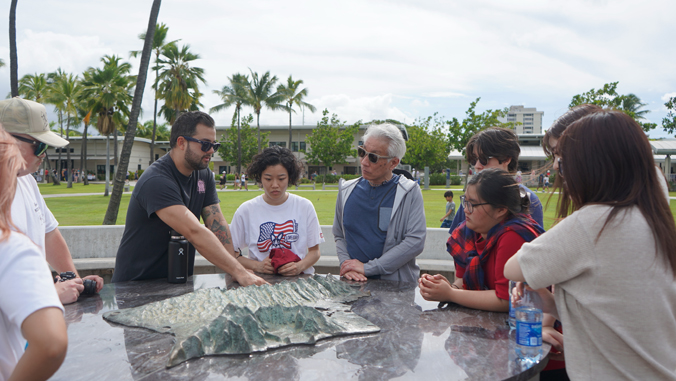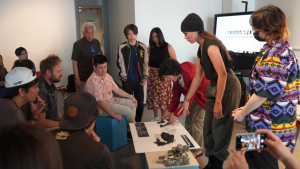
In an opportunity to discover architecture from a new perspective, five students and one faculty from the Nagaoka Institute of Design (NID) in Japan visited the University of Hawaiʻi at Mānoa School of Architecture as part of an international design exchange program from March 20–25.
The design exchange began with a careful analysis of sites on Oʻahu by UH Mānoa students, who selected Heʻeia State Park, the Lānaʻi Lookout and Diamond Head State Monument as potential sites with cultural significance and layered histories as locations for peace memorials.

- Related UH News story: Student travel to Japan enriches architecture exchange, March 7, 2023
After visiting the sites with NID students, and two intensive days of design workshops, three teams developed design installations that celebrated inner and outer peace, peace as something to maintain and peace as a journey.
“In Hawaiʻi, as designers, we are really accustomed to navigating cultural sensitivity in our designs, and it was really interesting to expand upon that in a new place,” said Sophia Collela, a second-year architecture student at UH Mānoa. “In Japan, when we went, we learned about another culture, and specifically about a sensitive event within that culture, and then bringing the students here as well. Now we were not only participating in learning about cultural sensitivity, but teaching it as well, in a place they were also unfamiliar with.”

“It was a good opportunity to understand how big the differences are between people from different countries,” said Shiho Ohkochi, a second-year NID student. “I want to treasure this experience and remember this feeling. It is a reason to exchange, to understand our differences and try to understand each other.”
NID students were able to experience a typical week at UH Mānoa’s campus. They interacted with other students and faculty and learned about the city and island from UH students’ perspective, offering a very different experience than they would have had as tourists.
“The design exchange offers students an opportunity to practice collaborating and cooperating in design teams, acknowledge strengths or weaknesses, and learn from their peers,” said Karla Sierralta, associate professor in the School of Architecture. “Students also gain new knowledge and a sense of responsibility as they present it to their guests, developing a new appreciation for local context and history. Overall, participants are exposed to diverse perspectives and the importance of mutual understanding.”
The Design Exchange Program is supported in part by the Hawaiʻi Architectural Foundation.

